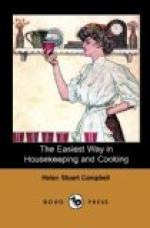Mutton requires fifteen minutes to the pound, unless preferred rare, in which case ten will be sufficient. If a tin kitchen is used, fifteen minutes for beef, and twenty for mutton, will be needed.
STUFFED LEG OF MUTTON.
Have the butcher take out the first joint in a leg of mutton; or it can be done at home by using a very sharp, narrow-bladed knife, and holding it close to the bone. Rub in a tablespoonful of salt, and then fill with a dressing made as follows: One pint of fine bread or cracker crumbs, in which have been mixed dry one even tablespoonful of salt and one of summer savory or thyme, and one teaspoonful of pepper. Chop one onion very fine, and add to it, with one egg well beaten. Melt a piece of butter the size of an egg in a cup of hot water, and pour on the crumbs. If not enough to thoroughly moisten them, add a little more. Either fasten with a skewer, or sew up, and roast as in previous directions. Skim all the fat from the gravy, as the flavor of mutton-fat is never pleasant. A tablespoonful of currant jelly may be put into the gravy-tureen, and the gravy strained upon it. The meat must be basted, and dredged with flour, as carefully as beef. Both the shoulder and saddle are roasted in the same way, but without stuffing; and the leg may be also, though used to more advantage with one.
Lamb requires less time; a leg weighing six pounds needing but one hour, or an hour and a quarter if roasted before an open fire.
ROAST VEAL.
Veal is so dry a meat, that a moist dressing is almost essential. This dressing may be made as in the previous receipt; or, instead of butter, quarter of a pound of salt pork can be chopped fine, and mixed with it. If the loin is used,—and this is always best,—take out the bone to the first joint, and fill the hole with dressing, as in the leg of mutton. In using the breast, bone also, reserving the bones for stock; lay the dressing on it; roll, and tie securely. Baste often. Three or four thin slices of salt pork may be laid on the top; or, if this is not liked, melt a tablespoonful of butter in a cup of hot water, and baste with that. Treat it as in directions for roasted meats, but allow a full half-hour to the pound, and make the gravy as for beef. Cold veal makes so many nice dishes, that a large piece can always be used satisfactorily.
ROAST PORK.
Bone the leg as in mutton, and stuff; substituting sage for the sweet marjoram, and using two onions instead of one. Allow half an hour to the pound, and make gravy as for roast beef. Spare-ribs are considered most delicate; and both are best eaten cold, the hot pork being rather gross, and, whether hot or cold, less digestible than any other meat.




